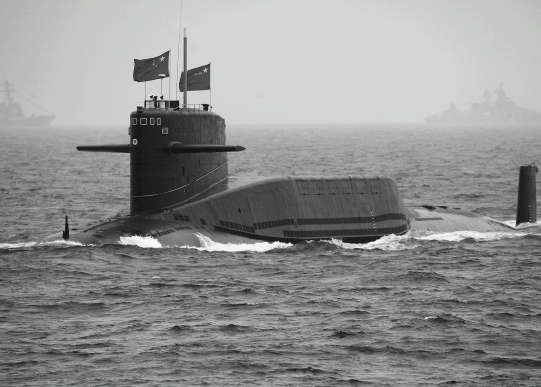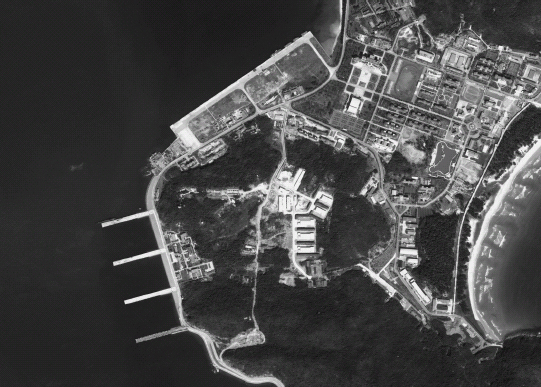
Question: Are Chinese ballistic-missile submarines now capable of striking American cities like Seattle, Chicago, and New York with nuclear warheads?
- No
- Yes
As every World War II–movie buff knows, one of the purposes of submarines is to attack and sink enemy ships. However, a second and arguably far more important role for the sub in this modern age is to serve as a critical component of a nation's nuclear-strike capabilities and therefore its nuclear deterrence.
As we briefly discussed in an earlier chapter, the concept of nuclear deterrence rests, first and foremost, on the reliability of a country's “second strike” capabilities. To wit: If I can strike your major cities back with a devastating salvo of nuclear missiles after you strike my cities first, you will be far less inclined to launch that first strike to begin with.
In fact, China and the United States have historically been characterized by starkly different levels of second-strike capabilities—with America the clear leader on this critical front. However, as American bard Bob Dylan's song says, “the times, they are a-changin’.”
Consider first, then, the American side of the deterrence ledger. Its second-strike capability certainly includes both land-based intercontinental ballistic missiles and long-range bombers. However, it is America's nuclear-powered ballistic-missile submarines—known as SSBNs (Ship, Submersible, Ballistic, Nuclear)—that arguably provide the most assured destruction in America's deterrent triad. Just why is this so?
Well, as previously noted, in today's high-tech Global-Positioning-System world, America's land-based missiles can now be far more easily destroyed in their fixed silos by precision strikes. At the same time, America's aging bomber fleet has become more and more vulnerable to the increasingly sophisticated air-defense systems of potential nuclear rivals like China and Russia.
In contrast, America's nuclear-powered submarine fleet suffers from no such vulnerabilities. With their supreme stealth capabilities and concomitant ability to travel ultra-long distances without surfacing, US subs are able to lurk in deep waters quite literally out in the middle of the ocean—but well within range of any country that may think about sending a first nuclear strike in America's direction. In this way, the fourteen vessels in the US fleet of ballistic-missile nuclear submarines have been America's best sentry dating back many decades to the earliest days of the Cold War.

Fig. 12.1. A Chinese Jin-class ballistic-missile nuclear submarine armed with Julang-2 missiles capable of hitting any city in America with nuclear warheads. (Photograph used with permission from REUTERS/Guang Niu/Pool.)
Of course, this “second strike at sea” situation has been quite the opposite for China, which historically has been unable to field a modern nuclear-submarine fleet. However, this particular strategic calculus radically changed in 2014 when China finally reached critical mass in the development and deployment of its new Jin-class ballistic-missile submarine. Longer than a football field, this Type 094 sub is capable of launching up to sixteen Julang-2 missiles with a range of up to 7,500 miles.
And here's some sobering math: China may have as many as five Jin-class submarines operational; and if each of their sixteen JL-2 missiles can indeed deliver up to four warheads each, as some analysts suggest, this would give China a combined ability to fire over three hundred nuclear warheads toward American soil1—thus giving the phrase “sleepless in Seattle” a whole new twist.

Fig. 12.2 China's “James Bond” underground base hiding ballistic-missile nuclear submarines that can hit Seattle and Los Angeles with nuclear warheads. (Photograph by DigitalGlobe/Scapeware3d. Used with permission from Getty Images.)
As for the actual threat China's new ballistic-missile nuclear subs may pose, some critics have sharply questioned their stealth capabilities. For example, George Washington University professor Amitai Etzioni dismisses China's naval arsenal in general as “junk” and discounts their submarines as “very loud.”2 In a similar, but more clinical fashion, researcher Christian Conroy claims that the Jin-class boats create “a detectable sonar signature,”3 while Professor T. X. Hammes of America's National Defense University just calls them “pretty noisy.”4
Note, however, a newer and quieter Type 096 Tang-class model is already in development—so China's newfound ability to field a credible second-strike capability should therefore not be underestimated. Seth Cropsey of the Hudson Institute has framed the need for caution:
Although their submarines are not as good as ours, they're inventive, imaginative, ingenious and excellent at copying; and I expect that they will turn out better and better boats in the future.5
It should also be noted that China's new ballistic-missile submarines can only function properly as a deterrent if they can freely and secretly roam from their Hainan Island base into the deeper waters of the Pacific—and thereby range much closer to American shores. However, to reach the relative safety of the Pacific, China's nuclear subs must first squeeze through any one of a number of choke points along the boundaries of the First Island Chain. During this run for deep waters, China's subs are therefore just as vulnerable to interdiction by American attack subs as America's ICBM fixed silos may now be to Chinese long-range precision-missile strikes. In contrast, American nuclear subs have no such choke-point worries because ports like Newport News and San Diego offer almost immediate deepwater access.
It is precisely because China believes it must break the bonds of the First Island Chain that China is building its relatively small fleet of ballistic missile nuclear submarines. However, to this end, China is also rapidly accumulating the largest, and most lethal, fleet of conventional diesel-electric submarines in the world. As we shall see in the next chapter, these diesel-electric boats may well pose an even greater danger to America and its allies than China's nascent nuclear-submarine fleet.